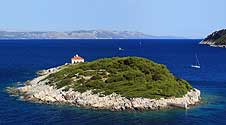National parks are spacious, mostly
untouched land or water areas of exquisite beauty. As examples of well
preserved eco-systems they are given the status of a national park so
their natural values would be protected from human intervention.
Moreover, they are important for their scientific, cultural and
educational values, and are sort of a refuge area where everyone trying
to escape hustle of urban life can come to and recreate.
- Brijuni – Situated on the south-west coast of Istria, Brijuni National Park encompasses a group of 14 islands and islets of exquisite beauty, with well preserved Mediterranean vegetation and examples of ancient Roman architecture and life.
- Kornati – Most indented group of islands in the Mediterranean is a magnificent labyrinth of 89 islands, islets and sea. Famous for its high cliffs and peculiar relief structures Kornati is considered to be a true sailor's paradise.
-
Krka
– Krka river, one of the most beautiful rivers in Croatia, created as
many as 7 waterfalls. The most popular are Skradinski Bik and Roški
slap, between which nests a lake and the small island of Visovac, the
site of a Franciscan monastery.
-
Mljet
– North-west part of this southern Dalmatia island was proclaimed
national park due to its harmonious combination of natural and cultural
heritage. Diverse and lush vegetation encloses ancient monuments and a
Benedictine monastery. There are also two bays which due to their very
narrow connection with the open sea look like salt lakes in the middle
of the island.
- Paklenica – Situated at the southern slopes of the biggest mountain range in Croatia, Paklenica National Park is famous for its two impressive canyons – Big and Small Paklenica – which stretch from the sea up to a height of over 700 meters.
-
Plitvice Lakes – The most famous national park in Croatia, Plitvice Lakes
is part of the UNESCO World Heritage List. It encompasses 16 small
lakes connected by cascades and waterfalls which are formed by
succession of travertine layers. The park is surrounded by thick beech
and fir forests, and partly even by a rainforest area.
-
Risnjak – This highly forested mountain range which
connects the Alps and the Dinarides encompasses very diverse flora and
fauna in a relatively small area: the brown bear, lynx, chamois, red
deer and short-toed snake eagle, to name only but a few. Beauty of the
forest, magnificent karst relief and splendid scenery attract many
mountaineers to this national park ever year.
- Sjeverni Velebit – North Velebit encompasses as many as four protected areas: special reservation Hajdučki and Ražanski kukovi, botanic reservation Visibaba, area of endemic sibiraea croatica and botanic reservation Zavižan-Balinovac-Zavižanska kosa, which is also the site of the monument of park architecture – Velebit botanical garden. Moreover, North Velebit National Park is part of International Biosphere Reserve.












